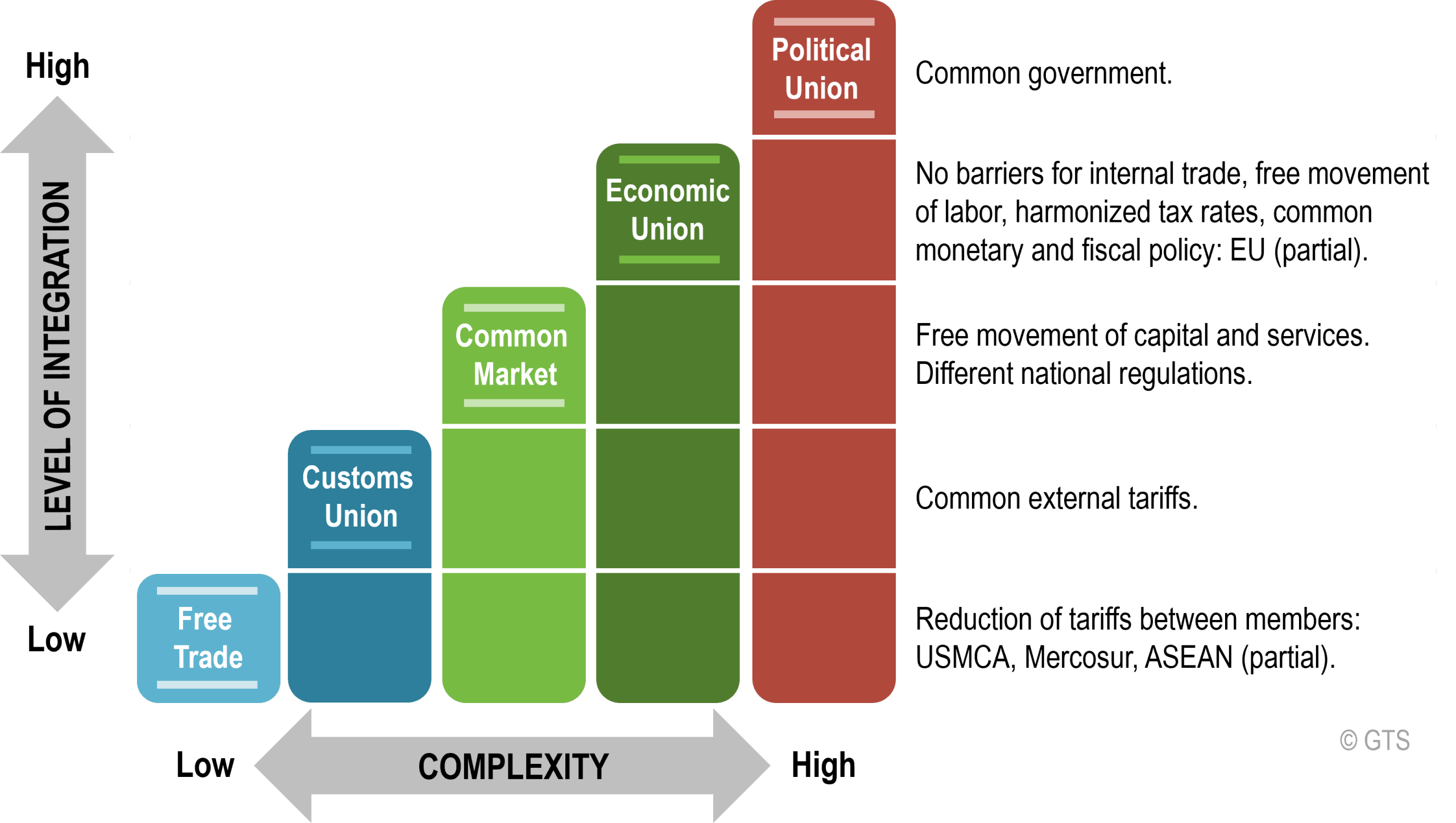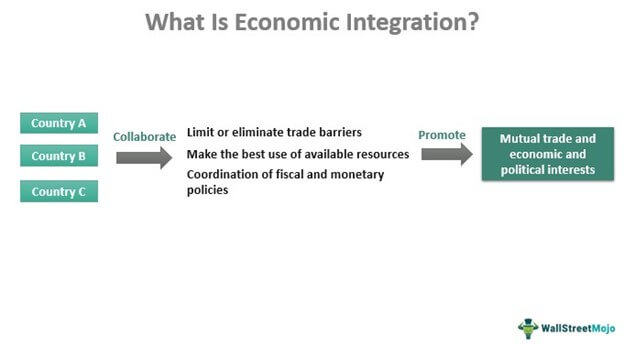
What is Economic Integration? Levels, Examples, and Why It Matters for Our Global World
In today’s interconnected world, you often hear about countries working together – signing trade deals, sharing common rules, or even using the same currency. This powerful trend is called economic integration, and it’s fundamentally shaping how nations interact, trade, and prosper.
But what exactly is it? And how does it work?
This comprehensive guide will break down economic integration into easy-to-understand concepts, explore its different levels, provide real-world examples, and explain why it’s so important for economies around the globe.
What is Economic Integration? A Simple Explanation
Imagine a group of friends deciding to share resources and work together on a big project. Economic integration is similar, but on a much larger scale, involving countries.
At its core, economic integration is the process by which countries reduce or remove barriers to trade and the movement of goods, services, capital, and people between them. Think of it as countries agreeing to play by similar economic rules, making it easier and cheaper to do business across borders.
The main goal? To increase economic cooperation, efficiency, and prosperity among the participating nations. It’s about breaking down walls to build bridges for trade and development.
Key Ideas Behind Economic Integration:
- Removing Barriers: This means getting rid of things like tariffs (taxes on imported goods), quotas (limits on imported goods), and complex customs procedures.
- Harmonizing Rules: Countries might agree on common standards for products, similar legal frameworks for businesses, or shared policies.
- Increasing Flows: Making it easier for goods, services, money (capital), and even workers to move freely between countries.
Why Do Countries Integrate Economically? The Benefits
Countries don’t just integrate for fun; there are significant advantages they seek to gain:
- Increased Trade and Economic Growth: By removing barriers, goods and services become cheaper and more accessible, leading to more trade and potentially faster economic growth for all members.
- Greater Efficiency and Specialization: Countries can focus on producing what they do best (specialization) and then trade with others, leading to more efficient use of resources and lower costs.
- Larger Markets: Businesses gain access to a bigger customer base, which can lead to economies of scale (producing more efficiently at a lower cost per unit).
- Increased Foreign Investment: A larger, more stable, and predictable integrated market can attract more investment from companies outside the bloc.
- Greater Political Stability and Cooperation: Economic ties often lead to stronger political relationships, reducing the likelihood of conflict and fostering cooperation on other global issues.
- Enhanced Bargaining Power: A bloc of countries can negotiate better trade deals with other countries or blocs than individual countries could on their own.
The Levels of Economic Integration: A Step-by-Step Ladder
Economic integration isn’t a one-size-fits-all concept. It happens in stages, like climbing a ladder, with each step involving deeper commitment and more extensive cooperation. Here are the main levels, from the least to the most integrated:
1. Preferential Trade Area (PTA)
- What it is: The most basic form of integration. Countries agree to lower, but not eliminate, tariffs on certain goods traded among themselves. It’s a selective agreement.
- Think of it like: A club where members get a small discount on some items, but not everything.
- Key Characteristic: Reduced tariffs on a limited number of goods.
- Example: The Southern African Development Community (SADC), while aiming for higher integration, started with preferential trade agreements among its members.
2. Free Trade Area (FTA)
- What it is: Countries eliminate all tariffs and quotas on all goods and services traded among themselves. However, each member country maintains its own independent trade policies with non-member countries.
- Think of it like: A neighborhood where houses trade freely with each other, but each house owner sets their own rules for trading with people from outside the neighborhood.
- Key Characteristics:
- No internal tariffs or quotas.
- Independent external trade policies.
- Often requires "rules of origin" to prevent goods from non-member countries from entering through the lowest-tariff member.
- Examples:
- North American Free Trade Agreement (NAFTA), now replaced by the United States-Mexico-Canada Agreement (USMCA).
- ASEAN Free Trade Area (AFTA) within the Association of Southeast Asian Nations.
3. Customs Union (CU)
- What it is: Builds on an FTA. Members not only eliminate internal tariffs but also adopt a common external tariff (CET) and common trade policies towards non-member countries.
- Think of it like: The neighborhood now has one shared gate and one set of rules for anyone trying to trade from outside.
- Key Characteristics:
- Free trade among members (like an FTA).
- Common external tariff and trade policy.
- Eliminates the need for "rules of origin" within the union.
- Examples:
- MERCOSUR (Southern Common Market), primarily involving Argentina, Brazil, Paraguay, and Uruguay.
- East African Community (EAC).
- Southern African Customs Union (SACU) – one of the oldest customs unions in the world.
4. Common Market (CM)
- What it is: Goes beyond a Customs Union by allowing the free movement of goods, services, capital, and labor (people) among member countries.
- Think of it like: The neighborhood now allows people to move freely between houses, work in any house, and invest their money in any house without restrictions.
- Key Characteristics:
- Free trade among members.
- Common external tariff.
- Free movement of factors of production (labor and capital).
- Example: The European Economic Community (EEC) was a common market before evolving into the European Union. Many regional blocs aim for a common market, even if they haven’t fully achieved it yet (e.g., CARICOM Single Market and Economy – CSME).
5. Economic Union (EU)
- What it is: The highest level of economic integration. It combines all features of a Common Market and adds harmonization of economic policies, including fiscal (taxation, spending) and monetary (interest rates, money supply) policies. It can also involve a common currency.
- Think of it like: The neighborhood now not only trades freely and allows free movement, but also has a shared budget, a common currency, and coordinated economic strategies.
- Key Characteristics:
- Free movement of goods, services, capital, and labor.
- Common external tariff.
- Harmonized economic policies (fiscal, monetary).
- May include a common currency.
- Example: The European Union (EU), particularly the Eurozone countries that share the Euro currency, is the most prominent example of an economic union. They have a common currency, a common central bank (ECB), and coordinated economic policies.
6. Political Union (Ultimate Goal, Beyond Pure Economics)
- What it is: While primarily economic, the deepest form of integration often leads to political integration. This involves a common government, common foreign policy, and common defense. It means a significant transfer of sovereignty from individual states to a supranational entity.
- Think of it like: The neighborhood eventually merges into one single, unified city with one mayor and one city council.
- Key Characteristic: Loss of national sovereignty in favor of a central, supranational government.
- Example: While the EU is an economic union, it also has significant elements of political integration (e.g., European Parliament, European Court of Justice), though it’s not a full political union in the sense of a single nation-state.
Real-World Examples of Economic Integration
Let’s look at some of the most well-known examples that illustrate these levels:
-
The European Union (EU): A Masterclass in Integration
- Level: Economic Union (with elements of political union).
- Key Features: Single market for goods, services, capital, and labor; common external trade policy; common currency (Euro) for many members; common agricultural and fisheries policies; significant political and judicial institutions.
- Impact: One of the world’s largest economies, promoting peace and prosperity among its 27 member states.
-
USMCA (United States-Mexico-Canada Agreement)
- Level: Free Trade Area (FTA).
- Key Features: Replaced NAFTA, eliminates tariffs on most goods traded between the three countries. Each country maintains its own trade policy with the rest of the world.
- Impact: Facilitates massive trade volumes across North America.
-
ASEAN (Association of Southeast Asian Nations)
- Level: Primarily a Free Trade Area (AFTA), with ambitions towards a Common Market (ASEAN Economic Community – AEC).
- Key Features: Reduced tariffs among members, working towards free movement of skilled labor, capital, and a more integrated market.
- Impact: Aims to create a single market and production base for over 650 million people, enhancing the region’s competitiveness.
-
MERCOSUR (Southern Common Market)
- Level: Customs Union, with aspirations towards a Common Market.
- Key Features: Free trade among its core members (Argentina, Brazil, Paraguay, Uruguay) and a common external tariff.
- Impact: Promotes trade and economic integration in South America.
-
African Continental Free Trade Area (AfCFTA)
- Level: Aims to become a Free Trade Area, with long-term goals for deeper integration.
- Key Features: Once fully implemented, it will be the world’s largest free trade area by number of participating countries, covering virtually the entire African continent.
- Impact: Hopes to boost intra-African trade, industrialization, and economic growth across the continent.
Challenges and Drawbacks of Economic Integration
While the benefits are significant, economic integration isn’t without its challenges:
- Loss of Sovereignty: Countries give up some control over their own economic policies, which can be a sensitive political issue.
- Job Displacement: Industries in one country might struggle to compete with more efficient producers in another member country, leading to job losses in specific sectors.
- Uneven Distribution of Benefits: Not all member countries may benefit equally, potentially leading to resentment or economic disparities.
- Policy Coordination Difficulties: Harmonizing policies among many diverse nations can be incredibly complex and time-consuming.
- Trade Diversion: Sometimes, integrating can mean a country trades less with more efficient non-member countries in favor of less efficient member countries, simply because of tariff advantages within the bloc.
Conclusion: A Path Towards a More Interconnected World
Economic integration is a powerful force shaping the global economy. From simple trade agreements to complex economic unions, countries are increasingly choosing to collaborate and reduce barriers to unlock greater prosperity, stability, and influence.
While the path to deeper integration can be complex and challenging, the drive to create larger, more efficient markets and foster closer international ties continues to be a defining feature of the 21st century. Understanding these levels and examples helps us appreciate the intricate web of economic relationships that govern our modern world.
Frequently Asked Questions (FAQs)
Q1: What is the main difference between an FTA and a Customs Union?
A1: An FTA eliminates internal tariffs but allows each member to set its own external tariffs. A Customs Union goes a step further by having a common external tariff for all non-member countries.
Q2: Does economic integration always lead to a common currency?
A2: No, a common currency (like the Euro) is characteristic of an Economic Union, the deepest level of integration. Lower levels like FTAs and Customs Unions do not require a common currency.
Q3: What does "rules of origin" mean in a Free Trade Area?
A3: Rules of origin are regulations that define where a product was made. In an FTA, they prevent non-member countries from shipping goods into a low-tariff member country and then re-exporting them tariff-free to another member country that has higher external tariffs.
Q4: Is economic integration always a good thing?
A4: While it offers many potential benefits like increased trade and growth, it also comes with challenges such as potential job displacement, loss of national sovereignty, and difficulties in policy coordination. The success depends on how well these challenges are managed.



Post Comment